Navigating the nuances of the jade gem reveals a tapestry of cultural richness and geological intrigue. Jadeite and nephrite, the two minerals classified as jade, are treasured both for their mesmerizing hues and the legends that echo through their history. In Chinese culture, jade is traditionally known as ‘yu’, symbolizing purity and virtue. The image of jade—its lustrous colour and captivating appearance—has inspired admiration for centuries. Across various cultures, jade holds deep significance in religion, playing a vital role in spiritual practices and beliefs, and is often regarded as a sacred object with religious connotations.
This straight-to-the-point guide demystifies jade’s allure, examines its two types, and shares practical insights into its symbolic, physical and healing properties and significance. Whether you’re an enthusiast or a newcomer, understand the true essence of jade, its revered status. The Chinese imperial family especially prized Jade for its symbolic qualities and ceremonial importance. In Chinese culture, jade symbolizes good luck and good fortune and is also referred to as the “Stone of Heaven.” Discover its contemporary charm.
Key Takeaways
-
Jade, encompassing both jadeite and nephrite varieties, is celebrated for its physical beauty, purported healing properties, metaphysical significance, and historical value, especially Imperial Jade, which is highly regarded.
-
Jade jewelry represents timeless elegance and modern fashion, blending seamlessly into various styles while offering emotional healing and protection through its connection with the heart chakra.
-
Maintaining jade's physical and spiritual qualities involves proper care and thoughtful integration into daily life, whether worn as jewelry, used in Feng Shui to attract prosperity and balance or as part of cultural and ceremonial traditions. Jade is also used in alternative medicine as a powerful tool for healing.
Exploring the Essence of Jade Gems
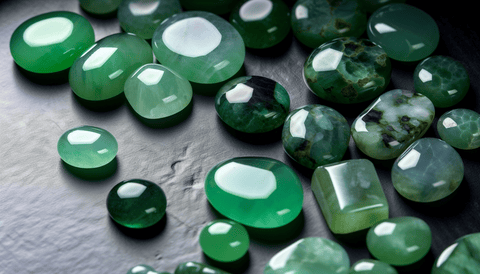
Jade, a remarkable stone revered across cultures, is not just a feast for the eyes but a wellspring of healing powers. With its imperial stature and grounding presence, jade stones are a beacon of confidence, acceptance, and health. Jade is commonly associated with virtues such as wisdom, compassion, and balance across many cultures. It also embodies Confucian virtues of wisdom, justice, compassion, modesty, and courage. Often called jade, this gem comes in myriad forms, from the regal imperial jade to the nurturing green stones, each piece a marvel of nature’s artistry.
But jade’s essence runs deeper than its physical beauty; it acts as a powerful cleansing stone, purifying the aura and enhancing well-being in subtle yet profound ways. In traditional healing practices, jade is also believed to support the health of various organs. Whether fashioned into jade pendants or unadorned in its natural birthstone form, the jade crystal resonates with the heart, offering a piece of the earth’s healing energies to all who cherish it.
The Two Faces of Jade: Jadeite and Nephrite

By Simon Eugster --Simon 17:50, 11 April 2006 (UTC) - Own work, CC BY-SA 3.0, https://commons.wikimedia.org/w/index.php?curid=697548
The term ‘jade’ encompasses two distinct minerals – jadeite and nephrite – each with its own spectral charm and geological tale. Jadeite jade, a precious stone belonging to the pyroxene group, boasts a crystalline structure that lends itself to a high degree of resistance against scratching, making it eminently suitable for enduring pieces like jade rings. Jade is crafted into a wide range of products, from jewelry to ornamental carvings and artifacts. Nephrite jade, historically celebrated in ancient China, once considered the pinnacle of hard stones, now shares the limelight with the rarer and often more valued jadeite, especially the revered Burmese jadeite. Nephrite is a silicate of calcium and magnesium, while jadeite is a silicate of sodium and aluminum, further distinguishing these two minerals. Interestingly, nephrite was deprecated as a mineral species name in 1978 but remains a correct term for the rock. Nephrite deposits are found in China, New Zealand, Russia, Guatemala, and the Swiss Alps. Additionally, jade is categorized into types based on treatment: Type B jade refers to jade treated with resin, while Type C jade is treated with colourant. Both nephrite and jadeite can have veins, blemishes, and streaks, which some consider valuable rather than flaws.
The spectrum of jade reveals its diverse personality, with Jadeite typically emerging as the more valued variety, thanks to its scarcity and rich historical connections to emperors and kings. This section will unfold the mysteries of imperial jade and the kaleidoscope of colours that jade can manifest, each adding a unique chapter to the saga of this versatile stone. Ancient civilizations such as the Aztecs also highly valued jade, using it in rituals and as a symbol of status. Nephrite typically appears in shades of green, yellow, white, and black, while jadeite varies in colour from white to black, including shades of green, lavender, orange, and brown. Nephrite ranges from mid to dark green or grey-green, and can also be white, yellowish, or reddish. Yellow jade symbolizes wisdom and clarity.
Mysteries of Imperial Jade
Imperial jade stands at the pinnacle of the jade pantheon, its value unparalleled, and its emerald green colour is a testament to the presence of chromium within its core. This jade's semi-transparent quality, akin to the finest of soaps, captivates the eye, enhancing its desirability and worth in the eyes of collectors and aficionados alike. In contrast, while still appreciated, brown jade does not hold the same prestige as its imperial counterparts, orange jade or yellow jade.
Indeed, the value of jadeite jade can fluctuate greatly, but none commands the market like the highest-quality Imperial Jade, a treasure of nature coveted for its colour and clarity. The allure of this dark green gemstone is not a modern phenomenon but rooted in ancient cultures; from the Shang dynasty to the contemporary era, Imperial Jade has been a symbol of power and purity. Emerald-green "Imperial jade" is regarded as the finest quality jade and is the most expensive.
Diversity in Hue: The Spectrum of Jade Colours
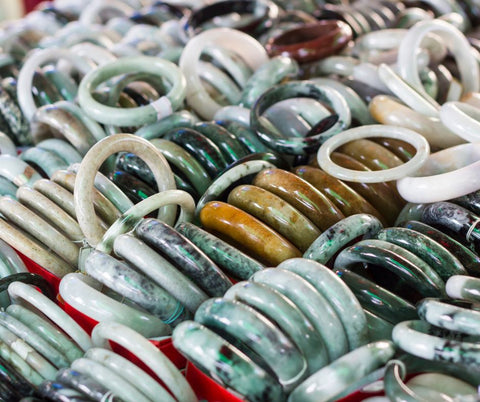
While green jade remains the most iconic, the jade stone palette encompasses a breathtaking array of hues, each with its own story and symbolism. From the serenity of lavender jade to the fervour of red jade, these colours traverse a spectrum that reflects the stone's inherent diversity. The emerald green of the cherished imperial jade signifies abundance in its fullest sense, encompassing material wealth and a serene, fulfilling inner peace. Jade comes in six different colours: green, red, yellow, lavender, black, and white.

This precious stone's colour is shaped by nature's alchemy, where impurities like chromic oxide weave the green crystals, and manganese imparts the gentle hues of lavender-purple jade. Conversely, the stark absence of these creates the purity of white jade, revered for its simplicity and ‘pure' essence. The value of green jadeite, deeply influenced by its translucence, becomes a dance of light and colour, with the most translucent stones often attaining the highest esteem, particularly in the case of dark green jadeite from Myanmar. Type A jade refers to natural, untreated jadeite, prized for its purity and vibrant colours.
Physical Properties of Jade: The Science Behind the Beauty
Jade’s enduring allure is rooted not only in its cultural mystique but also in its remarkable physical properties, which have made it a highly sought-after type of gemstone for generations. At its core, jade is a metamorphic rock formed under intense heat and pressure, resulting in a stone that is as durable as it is beautiful. The two main varieties—nephrite and jadeite—each bring their unique qualities to the world of jade jewelry and decorative masterpieces.
Nephrite, the more common type, is a calcium and magnesium-rich silicate mineral, prized for its toughness and smooth, cool texture. Its hues range from creamy white to deep, dark green and even brown, with subtle patterns that reflect the way the stone was formed. Jadeite, on the other hand, is rarer and considered the finest jade, especially when it displays a vibrant, even colour and high clarity. This sodium and aluminum-rich mineral is celebrated for its exceptional transparency and the vivid greens that have become synonymous with prosperity and harmony in the Far East. The most coveted jadeite often comes from Burma (Myanmar). At the same time, nephrite is commonly sourced from Canada, Siberia, and Taiwan—each place contributing to the global appreciation of jade’s beauty and quality.

One of jade’s most captivating features is its ability to appear cool and almost waxy to the touch, a tactile quality that enhances its appeal in pendants, jade earrings, and other forms of jade jewelry. The transparency of jade can vary dramatically, from completely opaque to translucent or even nearly transparent in the highest quality stones. This clarity, combined with the stone’s natural patterns and vibrant hues, is a key factor in determining value. Today, collectors and enthusiasts alike seek out pieces that display a harmonious blend of colour, texture, and light.
The Chinese name for jade, “yu,” reflects its significant role in Chinese culture, where it has long been associated with good fortune, prosperity, and healing. The Spanish term “piedra de ijada” (stone of the loin) also hints at jade’s traditional use in promoting the health of organs, particularly the kidneys. Across cultures, jade’s physical properties have inspired the creation of masterpieces—whether as intricate pendants, elegant jade earrings, or ceremonial objects—each piece a testament to the stone’s enduring significance.
When purchasing jade today, understanding its physical properties is essential. Look for stones with even colour, high clarity, and a smooth, cool texture. The finest jade will often be translucent, allowing light to play across its surface and reveal the depth of its natural beauty. By appreciating the science behind jade’s allure, you can make informed choices and truly value the role this extraordinary gemstone plays in cultures around the world.
Identifying Genuine Jade: Spotting the Real from the Replica
Identifying genuine jade is an essential skill for anyone captivated by this sought-after type of gemstone, especially in today’s global market where replicas are increasingly common. One of the most important ways to distinguish authentic jade is by examining its clarity and texture. Genuine jade, whether it’s a vibrant green jade or a more understated brown or white hue, typically feels cool to the touch and has a smooth, almost waxy surface. High-quality jadeite has a smooth, even surface, while nephrite has a resinous lustre when polished, compared to jadeite's glassy lustre. When purchasing jade, pay close attention to the stone’s patterns—natural jade often displays unique, intricate patterns and subtle colour variations that are difficult to replicate. Additionally, the sound test and scratch test can help differentiate genuine jade from imitations. Identifying genuine jade can be challenging, as both nephrite and jadeite can appear similar to the untrained eye.
In the Far East, where jade has played a significant role for centuries, experts rely on a combination of methods to verify authenticity. These include checking the transparency of the stone, as high-quality jade often allows light to pass through, and assessing the overall texture for a consistent, natural feel. Today, with the rise of online sales, understanding these characteristics is more important than ever. Whether you’re considering a jade pendant or a pair of jade earrings, always look for reputable sellers and request detailed images to inspect the stone’s hues and surface. By developing an understanding of these key features, you can confidently navigate the world of jade and ensure that your next purchase is a genuine treasure.
Jade Jewelry: Timeless Elegance and Modern Charm
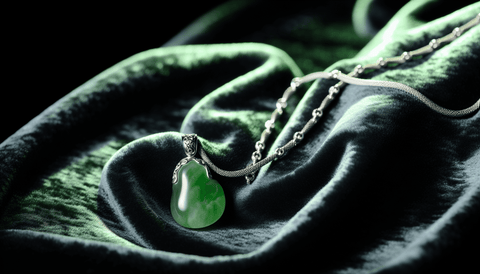
Jade jewelry, a harmonious blend of ancient majesty and contemporary allure, adapts effortlessly to the most opulent galas or the simplicity of everyday wear. The individuality of jade stones shines through in each unique design, ensuring that every jade ring or necklace is an exclusive masterpiece, a singular narrative etched in stone. Jade jewelry is often used to display the stone’s natural beauty and craftsmanship, highlighting its significance in both personal adornment and cultural expression. Jade also serves as a talisman for conducting financial transactions, further enhancing its practical and symbolic value.
From the subtle elegance of jade bracelets to the dramatic flair of statement necklaces, jade’s versatility is its hallmark. It allows wearers to express their style while tapping into the stone’s rich cultural heritage.
Modern jade jewelry, marrying the beauty of jade with the resilience of metals like sterling silver, is a testament to the gem’s timeless charm and evolution in the fashion world. Be ready to experience the transformative and healing properties of jade jewelry for yourself.
The Power of Green Stones: Healing and Fashion
The lustrous green jade, a stone that has long symbolized well-being and connection to Mother Earth, offers a dual delight of healing and style. Its association with the heart chakra infuses each piece of jade jewelry with the potential to balance emotional energies. At the same time, its aesthetic versatility ensures that wearing jade jewelry remains a fashion-forward choice.
A green stone's ability to cleanse and rejuvenate goes beyond mere aesthetics. It is believed to maintain the stone's power and amplify therapeutic energy when in contact with the skin, thus promoting a sense of serenity and contentment.
Whether it's the deep emerald of imperial jade or the gentle hue of other green gemstones, the healing properties of these green stones weave seamlessly into the fabric of fashion, offering a touch of nature's healing energies to those who adorn themselves with them.
The Metaphysical World of Jade: Beyond the Physical
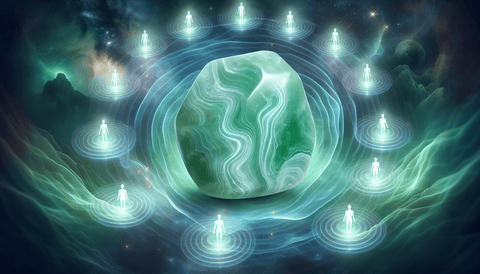
Jade’s allure extends into the metaphysical realm, where its meaning is revered as a protective stone, offering a shield against harm and a conduit for good fortune. The nurturing stone properties of jade and green jade, in particular, foster a sense of deep relaxation and inner peace, alleviating irritability and enveloping the wearer in tranquillity. These are some of the jade healing properties that make it so valuable. The healing properties of jade are also believed to include aiding in the healing of infections and physical injuries. Jade is also believed to support fertility and reproductive health. Additionally, jade is said to cleanse the body of toxins and aid in the body’s filtration system, further enhancing its reputation as a stone of well-being. Furthermore, jade may help in the healing of various physical ailments, including kidney problems and adrenal gland issues.
The tapestry of jade’s metaphysical properties is vast, including:
-
Black jade, which aids in self-control and is associated with power and protection
-
Blue jade, a beacon of peace and calm
-
Lavender jade is revered as the ‘Stone of the Angels,’ offering emotional and spiritual support, purifying the spirit, and enhancing serenity.
This stone’s remarkable ability to balance energies and improve psychic abilities connects the wearer to the spiritual world, promoting clarity and aiding in dream work through crystal healing. Jade is also thought to encourage honesty and authenticity in relationships.
Jade as a Dream Stone
The dream stone, or jade stone, is cherished for its ability to:
-
Bridge the spiritual and physical realms
-
Facilitate a deep connection to the metaphysical aspects of existence
-
Enhance lucid dreaming
-
Be a guide to understanding life's path and spiritual insights
The ancient Maya revered jade for these powers.
In the realm of sleep, jade acts as a protective talisman, warding off negative thought patterns and fostering a state conducive to visionary dreams. The properties of jade, particularly its role in promoting lucid dreaming, have been honoured across cultures, solidifying its status as a gemstone that transcends the physical to touch the essence of our subconscious desires and aspirations.
Combining Jade with Other Crystals: Unlocking Synergy
The beauty of jade jewelry lies not only in its timeless elegance but also in its ability to harmonize with other crystals, unlocking a synergy that amplifies its natural properties. In Chinese culture, jade is often combined with stones like amethyst to create masterpieces that are as meaningful as they are beautiful. This practice, rooted in centuries-old traditions, is believed to enhance the healing properties and good fortune associated with jade, while also reflecting the wearer’s unique style.
The Spanish piedra de ijada, or “stone of the loin,” is another crystal historically paired with jade to promote prosperity and well-being. When creating jade jewelry, such as a jade pendant or jade earrings, considering the properties of each stone is key. For example, combining nephrite jade with amethyst can foster harmony and balance, while also adding a touch of vibrant colour and energy to your collection. By understanding the different ways crystals interact, you can craft pieces that not only look stunning but also support your journey toward healing and happiness. Whether you’re drawn to the cool green of jade or the deep purple of amethyst, experimenting with combinations allows you to create jewelry that is both a work of art and a reflection of your soul.
Caring for Your Jade Gem: Maintenance and Preservation

Preserving jade’s lustrous beauty and potent energy requires thoughtful care and attention. Here are some tips to help you care for your jade:
-
Cleanse your jade with gentle soap and water.
-
Recharge your jade in the soothing rays of sunlight or the soft glow of moonlight.
-
Remove your jade before engaging in activities that might expose it to harsh impacts or chemicals.
By following these tips, you can ensure that your jade remains vibrant and effective in its spiritual abilities while preserving its physical integrity.
Storing jade separately from other jewelry helps prevent scratches while keeping it in a safe place and guards against accidental damage. Placing jade in specific locations, such as near your bed or workspace, can further enhance its protective and healing properties. A weekly light oiling with baby oil, followed by a soft cloth wipe, can keep polished jade gleaming, reflecting its physical allure and the depth of care invested in maintaining its powerful essence.
The Significance of Keeping Jade Close
Keeping jade close to one's being, in the form of jade pendants or bracelets, is more than a matter of aesthetics; it is a practice steeped in significance. Some of the benefits of wearing jade include:
-
Promoting focus and emotional healing, essential facets of physical well-being
-
Providing protection and fostering deep harmony
-
Contributing to both physical safety and mental balance
-
Ensuring the wearer is enveloped in a cocoon of well-being
To amplify the healing properties of jade or to add layers of emotional protection, consider pairing jade with complementary stones like peridot or malachite, which can create a powerful synergy of healing energies. Such combinations can reinforce jade's role as a nurturing stone, enhancing its ability to protect and soothe the wearer.
Integrating Jade into Your Life: Practical Uses and Decor

Incorporating jade into one’s life extends beyond the personal realm; it can also transform living spaces into havens of health, abundance, and balance. The presence of jade, whether as elegant lamps or sophisticated home accessories, not only elevates the aesthetics of an environment but also imbues it with a sense of luxury and harmony. The way jade is placed in home decor—such as positioning jade pieces in entryways or living areas—can maximize its energetic benefits and enhance the flow of positive energy throughout the space.
For those seeking a meditative aid, olive shades of jade can serve as a calming force, with jade beads or necklaces channelling healing energy during moments of quiet reflection.
Jade’s harmonious properties can be further harnessed by pairing it with stones such as amazonite and lapis lazuli, especially within spiritual practices. This creates a powerful support system for fostering inner peace and stability.
In the workplace, jade’s influence can enhance communication, attract prosperity and positive energy and ward off negative energies, reinforcing a grounding and positive presence that benefits personal well-being and professional success.
Feng Shui with Jade: Attracting Prosperity and Balance
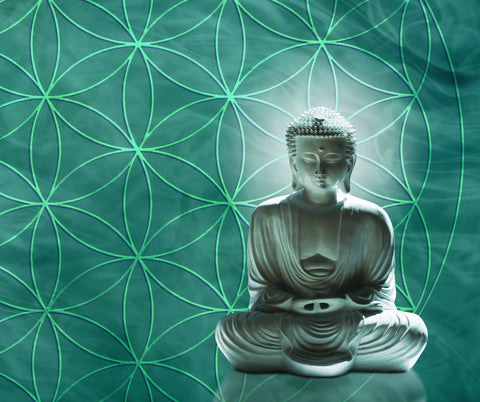
In the practice of Feng Shui, jade is a cherished ally, utilized to enhance the flow of chi and attract divine energies that foster harmony, happiness, and abundance. Its serene and balancing properties make it ideal for creating a nurturing environment conducive to health and prosperity.
The placement of jade in visible areas, whether as statues or tumbled pieces, cleanses the space of negative energies and invites good fortune, thus bringing harmony to both the home and the workplace.
Green Jade, in particular, is recognized as an abundance stone. Its divine energy influences material prosperity and enriches business and family relationships. The colour green is the most common shade of jade and is synonymous with the gemstone.
Incorporating jade into living spaces through decorative elements or purposefully positioned ornaments can foster a calming and spiritually nurturing environment that resonates with the energies of self-sufficiency and a protective talisman.
The Global Journey of Jade: From Ancient China to South America

Jade’s journey across time and continents is a testament to its enduring appeal and profound impact on civilizations. Across various religions, jade has held deep symbolic and spiritual significance, often used in religious rituals and as a symbol of faith. From the artisanal evolution during China’s Tang Dynasty to the dynamic craftsmanship of the Qing era, jade’s design and usage have continuously adapted, reflecting the tastes and themes appreciated by the elite of each period.
Beyond Asia, the rediscovery of Guatemalan jadeite jade has brought renewed attention to the stone’s historical and cultural importance, as chronicled by media outlets like National Geographic.
The stone’s living essence, its qi, has been a bridge between heaven and earth, imbuing jade with a mystical quality that transcends mere ornamentation. The principal sources of nephrite jade, particularly from the Xinjiang region and the city of Khotan, have played a crucial role in disseminating this gemstone, allowing its beauty and significance to permeate diverse cultures and epochs. In modern times, the sale of jade at specialized auctions, such as the Gems, Jade and Pearls Emporium, highlights the rarity and value of high-quality stones.
To truly appreciate jade’s legacy, consider planning a visit to jade markets or exhibitions, where you can experience the stone’s cultural and historical significance firsthand.
Jade's Role in Cultural Traditions
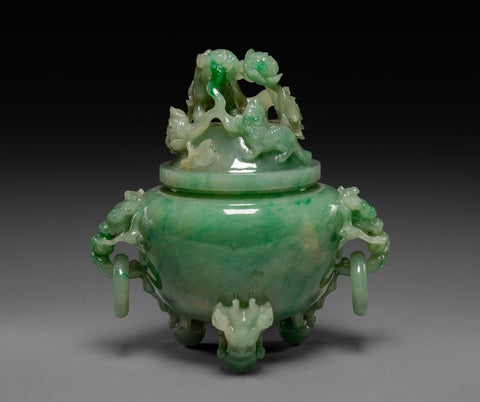
The revered gemstone jade has played a seminal role in cultural traditions, its significance woven into the very fabric of ancient societies. During the Neolithic period and the subsequent Shang Dynasty, jade was not merely ornamental but a key component of shamanistic rites and imperial rituals, serving as ceremonial tools and embodying mystical motifs. The reverence for jade was such that ritual objects like the bi disc and zong tubes, often found in burials, were considered of great ceremonial importance, signifying wealth and virtue. Jade has been used not only for decorative purposes but also for tools and weapons in prehistoric times due to its toughness. The Mayan and Aztec civilizations valued jade more than gold, regarding it as a precious gemstone. In ancient Egypt, jade was admired as the stone of love, inner peace, harmony, and balance. In New Zealand, the Maori culture used jade to adorn their masks and for mystical offerings.
In these ancient cultures, jade was more than a precious stone; it symbolized wisdom, peace, and harmony. Its sacred status was mirrored in both Chinese and Mayan civilizations, where jade was intertwined with love, justice, and emotional balance practices.
The enduring belief in jade's protective qualities and its association with immortality is exemplified by the elaborate jade burial suits of ancient nobility, designed to convey social status and safeguard the spirit on its journey to the afterlife.
Benefits of Investing in Jade: Value, Rarity, and Collectibility
Investing in jade offers a unique blend of beauty, rarity, and long-term value, making it a prized addition to any collection. The finest jade, especially the vibrant green jade from Burma, is highly sought after for its exceptional quality and clarity. In places like Taiwan, jade is celebrated as a national treasure, and collectors around the world—from Canada to Siberia—are drawn to its enduring allure and cultural significance.
When purchasing jade today, it’s important to consider not only the stone’s colour and transparency but also its provenance and craftsmanship. Masterpieces that feature jade, such as intricately carved pendants or elegant jade earrings, often command higher prices due to their artistry and the high quality of the stone. These pieces are not just beautiful adornments; they are investments that can be cherished and passed down through generations, carrying with them stories of prosperity and good fortune. Reputable dealers and jewellers are the best sources for quality jade purchases.
Jade’s value is further enhanced by its role in various cultures, where it is revered for its healing properties and symbolic connection to harmony and the soul. Whether you’re acquiring nephrite or imperial jade, each piece offers a unique opportunity to own a part of history and artistry. By visiting reputable dealers and learning about the different types of jade, you can make informed decisions and build a collection that reflects both your appreciation for beauty and your understanding of this remarkable gemstone’s place in the world.
Summary
As we draw the curtains on our exploration of jade, we are reminded of its remarkable journey from the lush mountainsides where it was first unearthed to the cherished positions it holds in our lives and cultures. Jade, in its myriad forms—from the coveted imperial jade to the soothing lavender purple jade—continues to fascinate and inspire with its blend of beauty, mystique, and metaphysical and healing properties. Whether gracing the halls of the mighty or resting gently against the skin, jade has proven itself to be a stone of immense value, offering protection, promoting healing, and symbolizing a connection to the divine.
Let the allure of jade stir a profound appreciation for the natural world and its treasures, and may the wisdom of ancient traditions guide us as we integrate this gemstone into our lives. From practical care to Feng Shui applications, the legacy of jade is one of balance, prosperity, and inner peace. Embrace the elegance of jade jewelry, the serenity it brings to our spaces, and the deep sense of well-being it can foster within us.
Frequently Asked Questions
What does the gem jade symbolize?
Jade symbolizes nobility and wealth and is considered a protector of both living and deceased generations. It has been called the "Gem Supreme" and the "Jewel of Heaven."
Is jade a rare gem?
Jade is not considered extremely rare but relatively uncommon compared to other gemstones. A significant demand for top-quality jadeite makes it relatively rare and highly valued.
Why is jade so special?
Jade is special due to its hardness, durability, subtle colours, and protective qualities, inspiring beautiful works of art and a rich body of lore throughout history. Its symbolism covers themes of harmony, eternity, and virtue, and when associated with gold, it was considered a symbol of heaven.
What distinguishes imperial jade from other types of jade?
Imperial jade is distinguished from other jade by its vivid emerald green colour, semi-transparency, and rarity, which are attributed to the presence of chromium. This makes it the most highly valued type of jade.
Can jade be used in Feng Shui, and if so, how?
Yes, jade can be used in Feng Shui to improve positive energy flow, attract Divine energy, and enhance health, prosperity, and overall well-being. It is used in statues, carvings, and tumbled pieces to cleanse the space and invite fortune.









